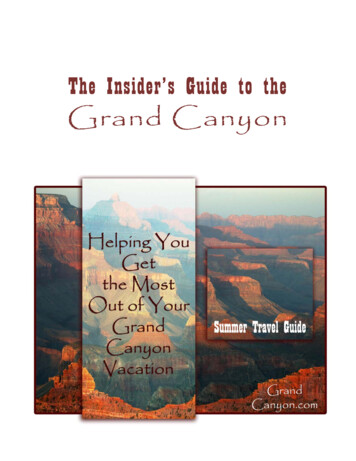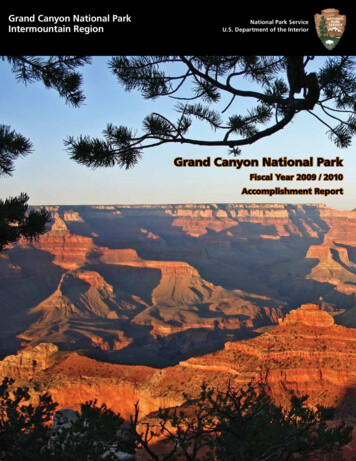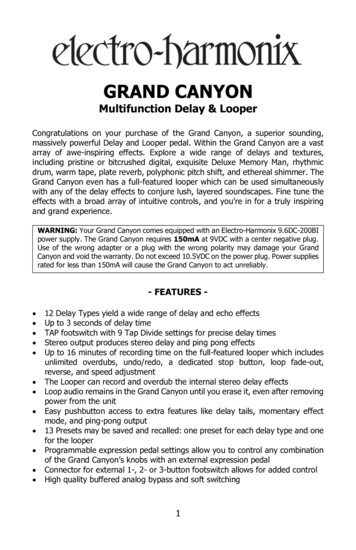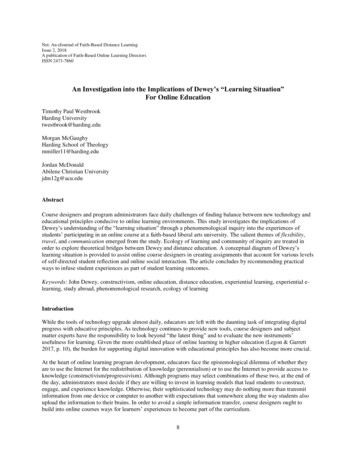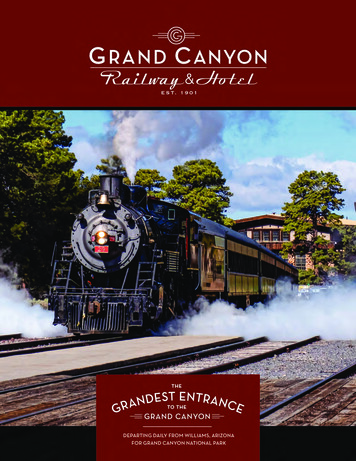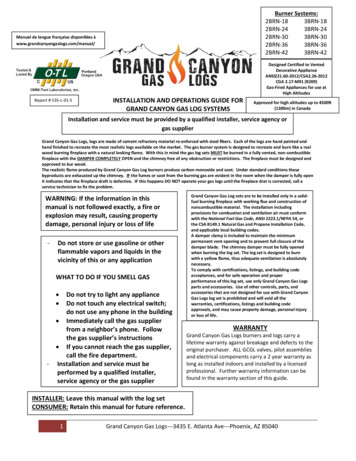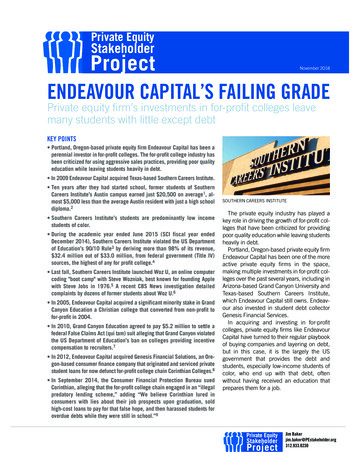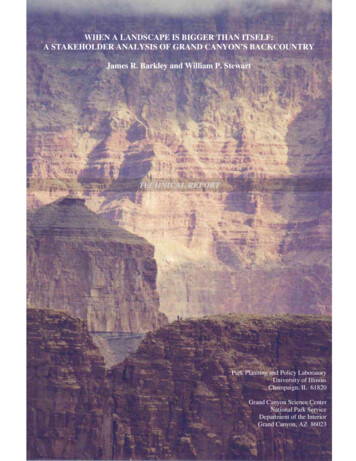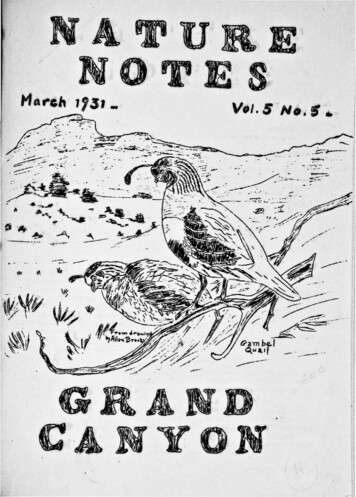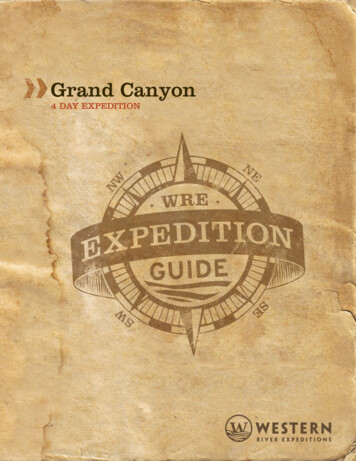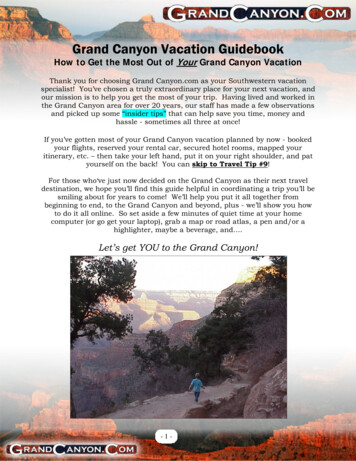
Transcription
Grand Canyon Vacation GuidebookHow to Get the Most Out of Your Grand Canyon VacationThank you for choosing Grand Canyon.com as your Southwestern vacationspecialist! You’ve chosen a truly extraordinary place for your next vacation, andour mission is to help you get the most of your trip. Having lived and worked inthe Grand Canyon area for over 20 years, our staff has made a few observationsand picked up some “insider tips” that can help save you time, money andhassle - sometimes all three at once!If you’ve gotten most of your Grand Canyon vacation planned by now - bookedyour flights, reserved your rental car, secured hotel rooms, mapped youritinerary, etc. – then take your left hand, put it on your right shoulder, and patyourself on the back! You can skip to Travel Tip #9!For those who‘ve just now decided on the Grand Canyon as their next traveldestination, we hope you’ll find this guide helpful in coordinating a trip you’ll besmiling about for years to come! We’ll help you put it all together frombeginning to end, to the Grand Canyon and beyond, plus - we’ll show you howto do it all online. So set aside a few minutes of quiet time at your homecomputer (or go get your laptop), grab a map or road atlas, a pen and/or ahighlighter, maybe a beverage, and .Let’s get YOU to the Grand Canyon!-1-
Travel Tip 1 – How Do I Find Grand Canyon on a Map?The Grand Canyon Park is located in Northern Arizona. It ismade up of several distinct areas: Grand Canyon NationalPark South Rim, Grand Canyon National Park North Rim,the Havasupai Indian Tribal Park, and Grand Canyon Weston the Hualapai Indian Reservation. Finding these areas on aGPS or online mapping site can be difficult as direct mailservice is not yet available to these areas. What’s more,popular sites such as MapQuest or Google may inadvertentlygive inaccurate information. At GrandCanyon.com, we’vefound that mapping these areas is best done as follows: Grand Canyon South Rim: use the locator codefor Grand Canyon National Park Airport, “GCN.” The park is 5 miles dueNorth of the Airport. Grand Canyon North Rim: use “Jacob Lake, Arizona” as your referencepoint. The park is 50 miles due South of Jacob Lake. Grand Canyon West: use “Meadview, Arizona” as your reference point,Grand Canyon West is 15 miles East of Meadview. Havasupai: Not applicable - there is no road access to this area. It is alsoclosed due to flooding and not scheduled to reopen until Summer 2009.GrandCanyon.com’s Grand Canyon Map PageInsider tip: DO NOT RELY 100% ON YOUR GPS OR OTHER AUTOMATEDNAVIGATIONAL AIDS WHEN DRIVING IN THIS PART OF THE COUNTRY. Arearoad information remains incomplete, and you may inadvertently be routed onto unpavedroads, which can be impassable in inclement weather or to vehicles without 4-Wheel drive.Most rental car insurance policies WILL NOT cover damage sustained by takingvehicles off-road!Travel Tip 2 – Which Grand Canyon Park Should I Visit?The Grand Canyon park area can be experienced in many different ways from severaldifferent sides. Which side you visit depends on several factors, such as the time of yearyou’re traveling, who you’re traveling with, how much time you have to spend, and whatkinds of activities you would like to take part in on your Grand Canyon vacation. Dependingon these factors, too, you may even be able to experience more than one Grand Canyon park.Grand Canyon National Park South Rim is open year-round and considered by many to bethe “true Grand Canyon.” Here you’ll find the vast, expansive views most often seen inmagazines and on TV. From the South Rim, you can view the Grand Canyon from close totwo dozen vantage points, each with their own unique attributes, some of which you can seethe Colorado River from. Approximately 5 hours’ drive from Las Vegas or Phoenix, theSouth Rim is the most easily accessible from most major Western cities and therefore is themost heavily visited. At 7,000’ above sea level, the South Rim has four distinct seasons ofweather from warm, dry summers to cold, snowy winters.-2-
Grand Canyon South Rim is most frequently chosen by first-time visitors to the area not onlyfor its beautiful views, but for its abundance of visitor services and family-oriented activities.There are 6 hotels inside the park, and 5 outside the park in the community of Tusayan.Restaurants, gift shops, visitor information and Grand Canyon tours are most plentiful atGrand Canyon South Rim. Popular gateway communities are Williams, Flagstaff and PageLake Powell. Grand Canyon South Rim is also recommended for those traveling with youngchildren, as there is more for them to do – and more that they can do - at the South Rim thanat the North Rim or West Rim. Hotel reservations for this area should be made 6 to 9 monthsin advance during peak travel season.Grand Canyon National Park North Rim is only openfrom mid-May through mid-October and is strikinglydifferent from the South Rim. The North Rim receives onlya fraction of the visitation the South Rim does. This ispartially due to it being less accessible from most majorWestern cities than the South Rim: 6 hours’ drive from LasVegas, 8 hours’ drive from Phoenix, and 7 hours’ drivefrom Salt Lake City. While the South Rim has close to twodozen major viewpoints, the North Rim has only three,which tend to highlight the width of the Grand Canyon more than its depth. Seeing theColorado River is next to impossible from the North Rim. At 8,000’ above sea level, springand fall days at the North Rim are crisp, and summers are warm and pleasant. Nighttime lowsremain quite cold until late spring, and can dip back down below freezing as early as August.The only in-park lodge at the North Rim, the Grand Canyon Lodge, has a couple hundredcabins and some motel rooms. Out-of-park lodging is also limited, with two small facilitiessituated within an hour of the park. The next nearest lodging is about 90 minutes from thepark in Kanab, Utah. Grand Canyon North Rim is best visited outdoors-minded peopleseeking a quiet getaway, especially those who’ve already been to the South Rim. Visitorstraveling in the fall, particularly late September, should seriously consider at least a brief visitto the North Rim to experience the spectacular fall colors of the Kaibab National Forest.Because of its high altitude, Grand Canyon North Rim is not recommended for those withcardiac or respiratory ailments. It is also not recommended for families traveling withyounger children, especially those who have a high requirement for sensory stimulation.Grand Canyon West is open year-round. It is a Tribal Parkowned and operated by the Hualapai Indian Nation thatgarnered sudden international fame with its star attraction:the Grand Canyon Skywalk. Grand Canyon West is mosteasily accessible from Las Vegas by car (3 hours - however,the main access road to the complex is presently unpaved for15 miles) or by package tour. Grand Canyon West has twoprimary viewpoints, from which the depth of the GrandCanyon is very pronounced and the Colorado River more easily visible. At 4,000’ above sealevel, Grand Canyon West is a true desert landscape.-3-
Grand Canyon West is very pleasant in early spring and late fall, and bearable in wintertime.Late spring and summer at Grand Canyon West are extremely hot, with daytime highs of 120 F, dust storms and high winds frequently reported.There is no lodging in the immediate area of Grand Canyon West. The nearest hotellodging is in Kingman, Arizona, 90 minutes’ drive away. In additionto the Skywalk, Grand Canyon West has a small airport, café, Westerntown, Indian Village, and an amphitheatre where visitors can watchNative American dances or cultural performances. Several GrandCanyon helicopter tour companies operate bases at Grand CanyonWest offering chopper rides to the bottom of the canyon for smoothwater pontoon boat rides on the Colorado River. Grand Canyon Westis a good choice for Las Vegas visitors with limited time for a GrandCanyon experience. It is also an excellent option for those who wantto get to the bottom of the Grand Canyon with minimal effort.Families traveling with very young children, extreme seniors, oranyone in less than robust health should probably pass on Grand Canyon West due to its drydesert climate and present lack of infrastructure.The Hualapai Tribe also operates the Grand Canyon’s only 1-Day White Water RaftingExpedition from the Hualapai Lodge in Peach Springs, Arizona. Inner Canyon Jeep Tours,which take visitors to the bottom of the Grand Canyon down the Diamond Bar Road on theHualapai Indian Reservation, are available from Williams or Grand Canyon South Rim.Havasu Canyon: Also located West of Grand Canyon NationalPark and the home of the Havasupai Indians, Havasu Canyon is atrue oasis in the desert. Its prize asset is three world-famous bluegreen waterfalls: Navajo Falls, Mooney Falls and Havasu Falls.Getting there is not easy: it is only accessible by foot, horseback orhelicopter. There is no road access whatsoever. Entrance to thecanyon for riders and hikers is via a 12-mile trail whose startingpoint is at Hualapai Hilltop, located 68 miles Northeast of PeachSprings. Helicopter airlifts are also available from the Hilltop on afirst-come first-served basis.Visitor facilities include a small hotel, campground, general store and post office. The fallsare located along a 3-mile trail from Supai Village. For more information on reservations forlodging, camping, saddle and pack horses, or helicopter transport, visitwww.havasupaitribe.com, or ask about Papillon Helicopters’ exclusive Havasupai Heli-HikeDay Tour from Grand Canyon National Park Airport. Havasu Canyon is best visited bythose who have planned ahead, and are healthy enough to make the 12 mile trek into and outof the Grand Canyon by foot or horseback. Those who arrange helicopter transport to SupaiVillage must still remember it is a 3-mile walk - each way – via a hot, dusty trail to thewaterfalls. Havasu Canyon is not recommended for families traveling with young children oranyone in questionable health.-4-
ADVISORY: Havasu Canyon and the infrastructure of Supai Village was heavily damagedby a flash flood in August of 2008. It is closed to visitors at press time (January 2009) and isnot expected to reopen until Summer of 2009. For updates, revisit the tribe’s website.Travel Tip 3 – What’s the Best Time of Year to Go?The four seasons are very distinct at the Grand Canyon, and not just in terms of weather.When you choose to travel will depend largely on who you’re traveling with. Most families,for example, will invariably visit the Grand Canyon in the spring and summer, when school isout. If you’re traveling with your spouse, a group of adults or perhaps solo, you’ll no doubthave more flexibility.For those able to pick and choose when to visit the Grand Canyon, our favorite times of yearare late spring and early fall. By late spring, we mean late April to early May. At this timeof year, Grand Canyon weather is typically very sunny and pleasant, with daytime highs at theSouth Rim ranging from 65 to 75 F. Breezy afternoons are the norm (as they are yearround), and wintry weather has been known to resurface at that time of year, but in general,the spring break crowds have subsided slightly and have yet to return to peak of summerlevels. Grand Canyon North Rim is not open until mid-May, therefore you would be limitedto visiting either Grand Canyon South Rim or Grand Canyon West in the springtime.Insider Tip: Spring can be an excellent time for viewing wildflowersthroughout Arizona. It is, of course, contingent on sufficient precipitation.To monitor wildflower blooms throughout the Southwest, visitwww.DesertUSA.com and click on the “Wildflower Report” link.At GrandCanyon.com, our favorite time of year is early fall (mid-September to earlyOctober). Grand Canyon weather is about as close to perfect as it gets with daytime highsalso in the 65-75 range. Late September is prone to occasional afternoon thunderstorms, butin general, sunny, breezy days predominate. The crowds also tend to thin out in the fall asschoolchildren get back into their regular routines. As mentioned in Travel Tip #2, GrandCanyon South Rim and Grand Canyon West are open year-round, so fall is a good time tovisit both of these areas as well.Insider tip: early autumn is prime time for a visit to theGrand Canyon’s prettier, cooler and quieter side – theNorth Rim. At 8,000’, Grand Canyon North Rimsupports plant and animal life that the drier South Rimcannot. In addition to Ponderosa pine trees, the KaibabNational Forest on the North Rim has oaks, birches, aspensand even some trees in the maple family. In about midSeptember, the forest breaks out in a dazzling array of autumn color that has to be seen to bebelieved (photo above right). The North Rim is in recovery from a major forest fire that tookplace in 2006, so there is a large burn area about 25 miles North of the park. Access to thatarea may be limited to facilitate revegetation and clean-up efforts.-5-
Summertime is the Grand Canyon’s warmest and most crowded time of the year. Ifyou’re not traveling with children and don’t have your heart set on having access to lots ofservices, activities, etc., here again, consider a visit to Grand Canyon’s North Rim. If you aretraveling with children, however, the South Rim will be your best bet as it has more of avariety of hotels, activities and tours that are kid-friendly. At 4,000’ in altitude, GrandCanyon West is more typical of a desert landscape, meaning treeless and HOT. If extremeheat bothers you, Grand Canyon West is best avoided in the summertime.In wintertime, the Grand Canyon almost becomes a different world. Thetime period from November through February is unquestionably thequietest time of year at the park, with only 15% of its annual visitationoccurring then. Since Grand Canyon North Rim closes from mid-Octoberto mid-May, you would want to choose between Grand Canyon West andGrand Canyon South Rim for a wintertime visit. Winter, as you canimagine, is very cold, with average daytime highs ranging from 35-50 F.Grand Canyon West will be slightly warmer. Nights are even chillier,typically getting down to the teens and even below zero on occasion. And of course, snow isa contingency one always has to plan for. But, if you’re seeking peace and solitude, and aphoto opportunity like no other, winter is a wonderful time to visit the Grand Canyon. Mostof the popular Grand Canyon tours are still operating, including those that go to the bottom.Insider tip: Save money by scheduling your trip between November 1st and March 1st, whenGrand Canyon hotels discount season can mean anywhere from 10 to 40 a night savings!Travel Tip 4 - How Do I Get to the Grand Canyon?FLYING:Most visitors begin their Grand Canyon vacations from one of several metropolitan airportswithin a day’s drive of the park. In order of popularity, they are:1. Las Vegas, Nevada (LAS),280 miles from the South Rim, average drive time 5 hours; 310miles from the North Rim, average drive time 5.5 hours2. Phoenix, Arizona (PHX),240 miles from the South Rim, average drive time 4.5 hours; 375miles from the North Rim, average drive time 6.5 hours3. Los Angeles (LAX),500 miles from the South Rim, average drive time 7.5 hours;570 miles from the North Rim, average drive time 9 hours;4. Albuquerque, New Mexico (ABQ),400 miles from the South Rim, average drive time 7 hours;490 miles from the North Rim, average drive time 8.5 hours;5. Denver (DEN),710 miles from the South Rim, average drive time 12 hours;670 miles from the North Rim, average drive time 11.5 hours; or6. Salt Lake City, Utah (SLC),410 miles from the North Rim, average drive time 7 hours-6-
Commuter flights are also offered into several municipal airports closer to the park: Flagstaff, Arizona (FLG) – connect from Phoenix or Los Angeles,85 miles from the South Rim, average drive time 1.5 hours;230 miles from the North Rim, average drive time 5 hours. Page, Arizona (PGA) – connect from Phoenix or Denver.150 miles from the South OR North Rim,average drive time 2.5 hours. St. George, Utah (SGU) – connect from Salt Lake City165 miles from the North Rim, average drive time 3 hoursCar rentals are available at all the above airports. For availability and pricing of flights andcar rentals, call (800) 916-8530. Grand Canyon National Park Airport [South Rim] (GCN) is primarily used as asightseeing and general aviation airport. Limited scheduled flights are available throughScenic Airlines out of Las Vegas/Boulder City (61B). Charter service is offered from othercities. Located in Tusayan, 1 mile South of the park entrance, drive time to South Rim 10minutes. No car rentals offered, but taxi service is available on an on-call basis.DRIVING:One of the most challenging aspects of Grand Canyon park travel is the distances betweenplaces. Things are more spread out here than you’re probably used to, so unless you fly intoone of the airports located near the park, be prepared to spend some time behind the wheel.You’re on vacation, so relax and enjoy the scenery! But don’t forget it can be a long waybetween gas stations, so fill up when you get the chance (see Travel Tip 26 about gas prices).DRIVING TO THE SOUTH RIM: From Las Vegas, Nevada - take Highway 93 Southeast toKingman, Arizona; in Kingman, take I-40 East to Williams, Arizona;from Williams take exit #165 North to Grand Canyon National Park.Average drive time: 5 hours.Insider tip: Leaving Las Vegas? Get an early start to avoid bypassconstruction delays at Hoover Dam (completion slated for 2010). From Phoenix, Arizona: Take Interstate 17 North to Flagstaff, Arizona; from Flagstaff,*take Highway 180 Northeast to Valle, Arizona; from Valle, take Highway 64 North to theGrand Canyon. * OR: *from Flagstaff take Interstate 40 to Williams, Arizona; fromWilliams, take Highway 64 55 miles North to Grand Canyon Village. The latter route is thebetter alternative in case of inclement weather. Average drive time: 4.5 hours From Flagstaff, Arizona: Take Highway 180 30 miles Northeast to Valle; From Valle,take Highway 64 25 miles North to Grand Canyon Village. OR take Interstate 40 toWilliams, Arizona; from Williams, take Highway 64 55 miles North to Grand CanyonVillage. The latter route is safer in inclement weather. Average drive time: 1.5 hours.-7-
From Williams, Arizona: Take Highway 64 North approximately 60 miles. Averagedrive time: 1 hour. From Page, Arizona: Take Highway 89 South to Cameron, Arizona; from Cameron, takeHighway 64 West to Grand Canyon Village. Average drive time: 2.5 hours.DRIVING TO THE NORTH RIM:REMINDER: Grand Canyon North Rim is CLOSED from October 15th – May 15th. From Las Vegas, Nevada: Take Interstate 15 Northeast to St.George, Utah; from St. George, take UT-9 to Hurricane, Utah; inHurricane, take UT-9 through Zion National Park to Kanab, Utah;in Kanab, follow Highway 89 to Fredonia, Arizona, where UT-11becomes Alt-89 (89A). Take 89A to Jacob Lake, Arizona. FromJacob Lake, Arizona, take Highway 67 South 60 miles into thepark. Average drive time: 6 hours. From Phoenix, Arizona: Take Interstate 17 to Flagstaff, Arizona. In Flagstaff, take US89 to Bitter Springs, Arizona; from Bitter Springs, take Alternate 89 (89A) to Jacob Lake,Arizona. From Jacob Lake, Arizona, take Highway 67 South 50 miles into the park.Average drive time: 7.5 hours. From Salt Lake City, Utah: Take I-15 South. About 10 miles South of Beaver, Utah,take UT-20 East for about 20 miles. Take US89 South to Kanab, Utah. In Kanab, follow thesigns to Fredonia, Arizona, where UT-11 becomes Alt-89 (89A). Take 89A to Jacob Lake,Arizona. From Jacob Lake, Arizona, take Highway 67 into the park. Avg drive: 8 hours. From Page, Arizona: Take US89 South to Bitter Springs, Arizona; from Bitter Springs,take Alternate 89 (89A) to Jacob Lake, Arizona. From Jacob Lake, Arizona, take Highway67 South 50 miles into the park. Average drive time: 2.5 hours.DRIVING TO GRAND CANYON WEST:Before you commit to driving to Grand Canyon West, note that15 miles of its primary access road is unpaved. Only properlyequipped vehicles (4WD with adequate clearance) should travelthis road. Rental car agencies openly discourage their clientsfrom driving on this road as their insurance policies will NOTcover damage sustained by driving off-road. It is stronglyrecommended that you use Grand Canyon West’s “Park andRide” service, available from the turn-off near Meadview, Arizona for a nominal fee. From Las Vegas, Nevada: Take U.S. 93 south to Hoover Dam; continue south another 40miles to the Dolan Springs/Meadview City/Pierce Ferry Road exit. Turn left and followPierce Ferry Road to Diamond Bar Road (about 28 miles). Turn right at the sign and stay onDiamond Bar Road to Grand Canyon West (about 21 miles). Average drive time: 3 hours.-8-
From Phoenix, Arizona: Take U.S. Highway 93 Northwest 105 miles; get on Interstate40. Take I-40 West to Kingman, Arizona. In Kingman, take U.S Highway 93 north about 30miles to Dolan Springs/Meadview City/Pierce Ferry Road exit. Follow Pierce Ferry Road toDiamond Bar Road (about 28 miles). Turn right at the sign and stay on Diamond Bar Road toGrand Canyon West. Average drive time: 5 hours. From Grand Canyon South Rim: Take AZ64 South to Williams, Arizona, get onInterstate 40. Take I-40 West to Kingman, Arizona. In Kingman, take U.S Highway 93 northabout 30 miles to Dolan Springs/Meadview City/Pierce Ferry Road exit. Follow Pierce FerryRoad to Diamond Bar Road (about 28 miles). Turn right at the sign and stay on Diamond BarRoad to Grand Canyon West. Average drive time: 4 hours.BY TRAIN:Scheduled train service is provided by AMTRAK from many major U.S. cities to Williams orFlagstaff, Arizona. For more information on scheduled train service to Grand Canyongateway cities call 1-800-USA-RAIL or visit www.amtrak.com. Open Road tours offersdaily shuttle service from both Williams and Flagstaff to Grand Canyon South Rim (seeContact List, page 35).Insider tip: AMTRAK’s arrival and departure times to Williams and Flagstaff are somewhatinconvenient. Westbound trains arrive/depart very late in the evening (10-11 PM); Eastboundtrains arrive/depart very early in the morning (4-5 AM). This can make hotel arrangementsproblematic since early check-ins and/or late check-outs are usually not available.From Williams, Arizona: get to Grand Canyon South Rim “OldWest” style, on the Grand Canyon Railway ! Relive the journeyundertaken by travelers throughout two centuries, in a genuinesteam train dating back to the early 1900’s, aboard one of fiveclasses of passenger cars: Pullman Coach, Budd Coach, FirstClass, Observation Dome and Luxury Parlor Car. The GrandCanyon Railway operates year-round, rain or shine (except for Christmas Eve and ChristmasDay), departing daily from Williams, Arizona, with a 3-4 hour layover at the South Rim(layover time varies by season). Overnight packages are also available where you can spendthe night at the historic Grand Canyon Railway Hotel in Williams and/or inside GrandCanyon National Park. Visitors traveling during the winter season can also take advantage ofspecial discounts, or enjoy the popular Polar Express Tour.Insider tip: The Pullman Coach car of the Grand Canyon Railway is not air-conditioned,which is not a problem in fall, winter or spring, but can be uncomfortable in the summermonths. If you prefer an air-conditioned ride, choose First Class, Observation Dome orLuxury Parlor Cars. Children must be at least 11 to ride in the Dome or Parlor cars; all agesare welcome in First Class and Coach. For more information, visit www.GrandCanyon.comor call 1-866-944-7263 or 7-928-645-6845-9-
BY BUS: Greyhound has scheduled bus service to Grand Canyon gatewaycities such as Phoenix, Flagstaff, Las Vegas and St. George (Utah).Scheduled shuttle service from Phoenix, Flagstaff and Williams isprovided several times daily by Open Road Tours (p. 35).A guided Grand Canyon Bus Tour is a great way to see the GrandCanyon when your time and/or funds are limited. From Las Vegas,Motorcoach day tours to both Grand Canyon South Rim and Grand Canyon West are offereddaily. Prices include pickup and dropoff at most major hotels on the Strip and Downtown,plus lunch. Popular add-on options include a 30-minute helicopter ride for the South Rimtour and the Grand Canyon Skywalk for the West Rim Tour. Duration from hotel to hotel is15 hours for the South Rim tour and 12 hours for the West Rim Tour.Day bus tours are also offered from other destinations such as Phoenix/Scottsdale, Flagstaffand Sedona (see Contact List, pages 35).Travel Tip 5 - Where Should I Stay?There are 6 hotels inside the park at Grand Canyon SouthRim: the El Tovar Hotel, Kachina Lodge, ThunderbirdLodge, Bright Angel Lodge, Maswik Lodge and YavapaiLodge. The El Tovar Hotel and Bright Angel Lodge areregistered National Historic Landmarks. The El Tovar Hotel,Kachina Lodge, Thunderbird and Bright Angel Lodge aresituated on the very rim of the canyon; Maswik and YavapaiLodge are ¼ mile and 1 mile from the canyon rim respectively.Grand Canyon South Rim hotels are typically booked 8 months to a year in advance frommid-March through mid-September, as well as for major wintertime holidays such asThanksgiving, Christmas, New Year’s and the Martin Luther King and Presidents’ Dayholidays. All in-park lodging at the South Rim is managed by Xanterra South Rim LLC. Forreservations, visit www.grandcanyonlodges.com or call 888-297-2757, or 303-297-2757Inside the park at the North Rim, there is only one hotel: theGrand Canyon Lodge, which consists of cabins and some motelrooms. This lodge is also usually booked well in advance duringseason, which is only from mid-May through mid-October. Theconcessionaire for Grand Canyon Lodge on the North Rim isForever Resorts. For reservations and information, visitwww.grandcanyonlodgenorth.com or call 877-386-4383.If your trip is within peak season and less than 3 months away, you are unlikely to beable to secure lodging inside the park. Your best bet will be to look to park’s “gatewaycommunities” (cities and towns located nearby) for your Grand Canyon lodging.- 10 -
South Rim Gateway Lodges and CommunitiesTusayan is located an easy 7 miles (10 minutes) from Grand Canyon South Rim. Themost popular hotels in this area among GrandCanyon.com’s clients are: The Best Western Grand Canyon Squire InnThis Grand Canyon hotel offers the most for families, like anon-site play center with a 6-lane bowling alley, video arcade,and billiard tables. The Squire offers both fine dining andfamily style restaurants, as well as 2 cocktail lounges, giftshop, outdoor pool and Jacuzzi, workout room, salon, giftshop, even a cowboy museum. Other hotels in Tusayan include: The Grand Hotel, Tusayan’s newest hotel The Quality Inn Canyon Plaza, next door to the IMAX Theatre The Holiday Inn Express, which has year-round heated indoor pool The Red Feather LodgeFor availability and pricing of these hotels, call (800) 916-8530.If hotel rooms are not available in Tusayan, your next best options will be:The Grand Canyon Inn in Valle, Arizona, 30 miles South of the parkThe Cameron Trading Post in Cameron, Arizona 60 miles East of the VillageWilliams, Arizona , 60 miles South of the parkFlagstaff, Arizona , 85 miles Southeast of the parkPage/Lake Powell, Arizona , 150 miles Northeast of the South AND North RimNorth Rim Gateway Lodges and CommunitiesIf you’re going to Grand Canyon North Rim, a variety of lodging choices are available inseveral neighboring towns:The Kaibab Lodge , 30 miles North of the park (open seasonally)The Jacob Lake Inn at Jacob Lake, Arizona, 60 miles North of the parkMarble Canyon Lodge , at Lees Ferry, Arizona, 90 miles North of the parkCliff Dweller’s Lodge , at Lees Ferry, Arizona, 90 miles North of the parkKanab, Utah , 100 miles Northwest of the parkPage/Lake Powell, Arizona150 miles Northeast of the North AND South RimSt. George, Utah, 180 miles NorthwestSpringdale, Utah, 180 miles Northwest, near Zion National ParkFor availability and pricing of hotels in Kanab, Page/LakePowell, St. George or Springdale, call 1-800-916-8530.Grand Canyon West LodgingThe nearest lodging to Grand Canyon West is in Kingman, Arizona , about 90 minutesSouthwest of Grand Canyon West. Laughlin, Nevada, 2 hours away, is another excellentchoice. For more information on hotels in these cities, or any other stops on your tour, visitwww.GrandCanyon.com/hotels.html or call (800) 916-8530.- 11 -
In Peach Springs, the Hualapai Lodge offers hotel-styleaccommodations, with a restaurant and gift shop, about2.5 hours away from Grand Canyon West. For bookinginformation visit www.destinationgrandcanyon.com , orphone 928-769-2230). 10 minutes South of PeachSprings is the Grand Canyon Caverns Inn, a familyowned facility (photo left) easy access of the GrandCanyon Caverns (www.gccaverns.com or phone928.422.3223).Insider tip: Hualapai Lodge is situated near a train route and trains pass frequently at night.Light sleepers may prefer to choose the Grand Canyon Caverns Inn.Travel Tip 6 - How About Camping or RV Parks?At Grand Canyon South Rim, trailer sites with hook-ups and tentsites are offered at Trailer Village, which is managed by XanterraSouth Rim LLC (www.grandcanyonlodges.com , 888/297-2757 or303/297-2757). Tent sites and limited trailer sites are also offered atMather Campground, which is near Trailer Village. MatherCampground does not have hook-ups for trailers, but does have a dumpstation, pay showers and a Laundromat at the Camper Servicesbuilding.At the North Rim, the campground is open from mid-May through mid-October. There areno trailer hook-ups, but a dump station is available. In-park campgrounds for both North andSouth Rims are administered by the National Park Reservation Service. Advancereservations are strongly recommended for Grand Canyon camping during peak travelperiods
The Hualapai Tribe also operates the Grand Canyon's . only - 4 - 1-Day White Water Rafting Expedition from the Hualapai Lodge in Peach Springs, Arizona. Inner Canyon Jeep Tours, which take visitors to the bottom of the Grand Canyon down the Diamond Bar Road on the Hualapai Indian Reservation, are available from Williams or Grand Canyon South Rim.
